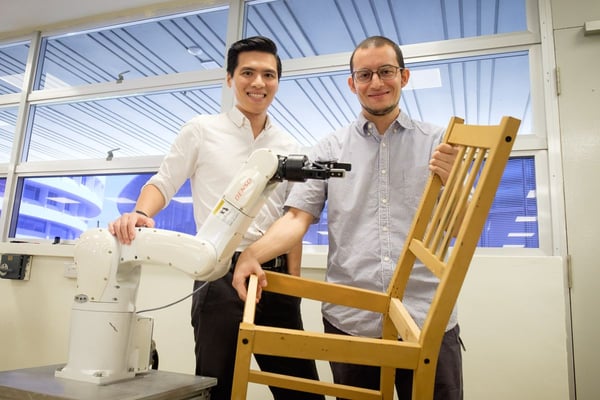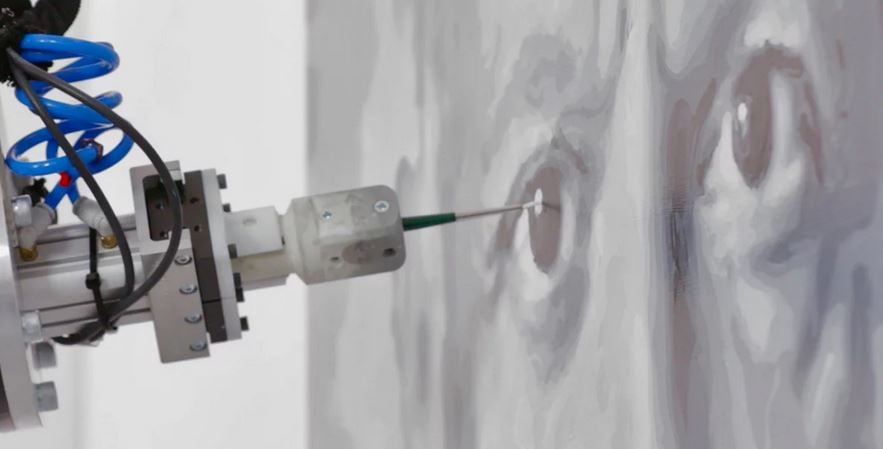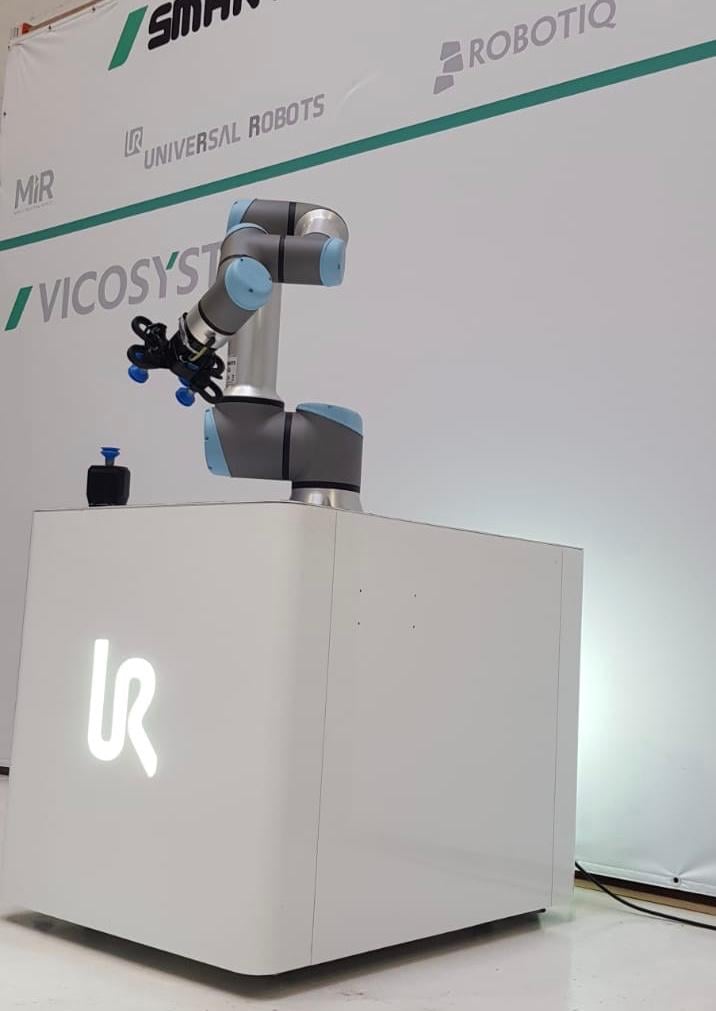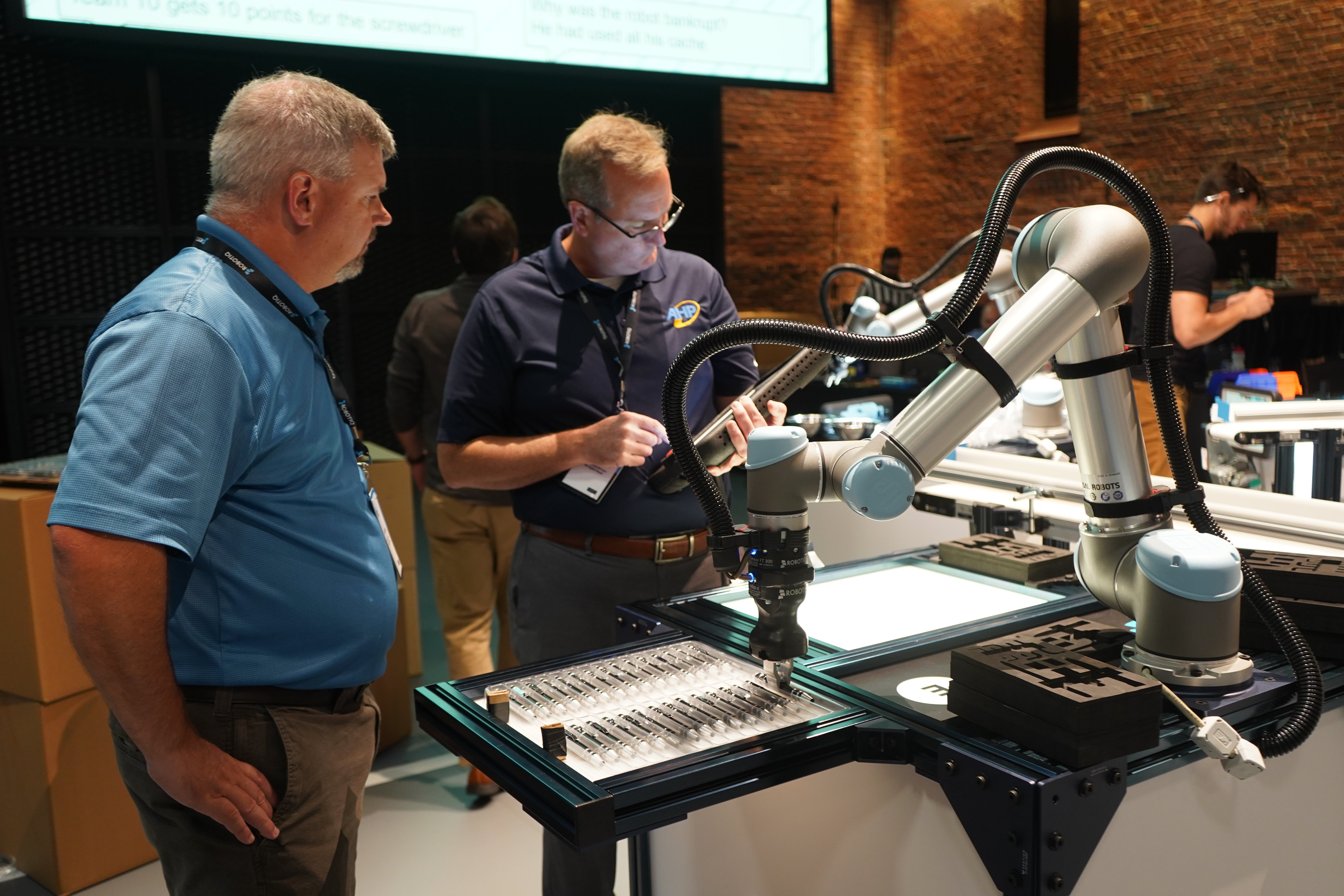The Man Behind the Robot That Built an IKEA Chair: Francisco Suárez-Ruiz, NTU Singapore

Posted on May 23, 2018 7:00 AM. 5 min read time
INTERVIEW: NTU's Francisco Suárez-Ruiz tells us about the recent IKEA chair assembly project, the important role of Robotiq's 2-finger grippers, human-robot collaboration, and his team's future plans.
Pham Quang Cuong (L) and Francisco Suárez-Ruiz (R) show off the robot-assembled IKEA chair.
(Image: Nanyang Technological University, Singapore.)
Francisco Suárez-Ruiz has been all over the news recently, from Wired and CNN to Reuters and beyond.
The Colombian-born roboticist and research fellow (at the CRI Group at Nanyang Technological University (NTU) in Singapore) led the team that built a robotic system capable of assembling an IKEA chair.
The system comprises a 3D camera and two robotic arms equipped with Robotiq 2-finger adaptive grippers, and supported by coded algorithms built on four different open-source libraries (OpenRAVE, OpenCV, ROS, and PCL).
In total, the assembly process took 20 min 19 s: 3 s for localization, 11 min 21 s for motion planning, and 8 min 55 s for execution.
Suárez-Ruiz (whose research interests include robotic arm manipulation, path planning, grasping, and computer vision), kindly agreed to an interview with Robotiq.
Robotiq: Congratulations on the success of your project and the global media coverage.
S-R: Thanks. We were expecting some interest, but the media coverage has been massive and it has far exceeded our expectations.
Robotiq: Using off-the-shelf components makes an interesting statement, inasmuch as it shows that existing technology can be used to accomplish surprising new tasks. Why did you take this approach?
S-R: We wanted to develop capabilities that can be deployed elsewhere in the industry. By using off-the-shelf components, we show the manufacturing industry – which tends to be skeptical – that it’s possible.
Robotiq: What criteria did you have in mind when choosing a gripper?
S-R: When selecting the gripper, we were looking at opening and force ranges as well as available interfaces with open-source tools such as ROS.
One additional factor was that I already had experience with using Robotiq's 3-finger gripper from my PhD research. (Robotiq note: for more details, see Grasp Mapping Between a 3-Finger Haptic Device and a Robotic Hand.)
I like how the combination of active and underactuated DoFs results in a versatile gripper that is easy to control, and my previous experience gave us confidence that we were going to succeed in this project.
Robotiq: Why did you choose the 2-finger gripper for the recent IKEA assembly project?
S-R: The fact that the 2-finger gripper has only 1 DoF forced us to simplify the grasping problem as much as possible.
Robotiq: I imagine that enabled you to eliminate a lot of unnecessary math and computation?
S-R: Yes. It simplified the requirements of the grasp planning component.
Robotiq: How about the integration process: what was it like to integrate the gripper and the robot arm?
S-R: Integration was very easy. We just had to manufacture one coupling plate to attach the gripper to the F/T sensor.
On the software side, all our devices use Ethernet with different protocols, which in the case of the Robotiq gripper is Modbus/TCP-IP. So the integration with our software architecture was easy as well.
(French language)
Robotiq: What role, if any, do you foresee for humans in systems like the IKEA chair-assembling bot? If the same system (or a cell) used a human and a robot to achieve the same end, do you think that would make a difference (e.g. in terms of task completion times), and how might you divide the labor?
S-R: Because we worked with traditional industrial robots rather than cobots, there was no role for humans in the system we developed. With industrial robots, the role of humans is limited for safety reasons.
If the robots were collaborative, I would imagine some human-robot collaboration would result in faster chair assembly.
I'm not sure about dividing tasks between human and robots – I'm not an expert in that subject – but I can imagine some collaboration in the form of handing over pieces, manually fastening screws, etc.
Robotiq: If you were tasked with designing and deploying a manufacturing cell with high production requirements and quality standards for assembly of IKEA chairs, would you use the current system or a human-robot collaborative design?
S-R: Under those requirements, I think a collaborative system would make more sense. Such a system would definitely help in terms of task completion times and flexibility of the system. With the new developments in AI, I think the hard parts (from a collaboration perspective) like ‘reading’ human intentions are much closer to being solved, so I would expect human-robot collaboration to grow even more over the years.
Robotiq: What's next for this project?
S-R: For now, the team is exploring the possibility of using AI to help the robot figure out the sequence of instructions from a manual. This is something we are just starting to explore.
We've also started working with other exciting applications, such as handling, drilling, glue dispensing, and inspection, where several of the capabilities developed to assemble the IKEA chair can be applied.
Robotiq: Do you have any plans to commercialize the technology?
S-R: Yes; in fact, the team has been working on commercializing the technology for the past year. We are currently focusing our efforts on industrial applications that are pain-points in existing production lines, particularly in the high-mix low-volume sector.
Robotiq: Thanks again for speaking with us. It's great to see our grippers being used in exciting research work like yours.
S-R: Thanks for having me.
Further reading:
“Can robots assemble an IKEA chair?,” Science Robotics: Volume 3, Issue 17, April 2018.









Leave a comment